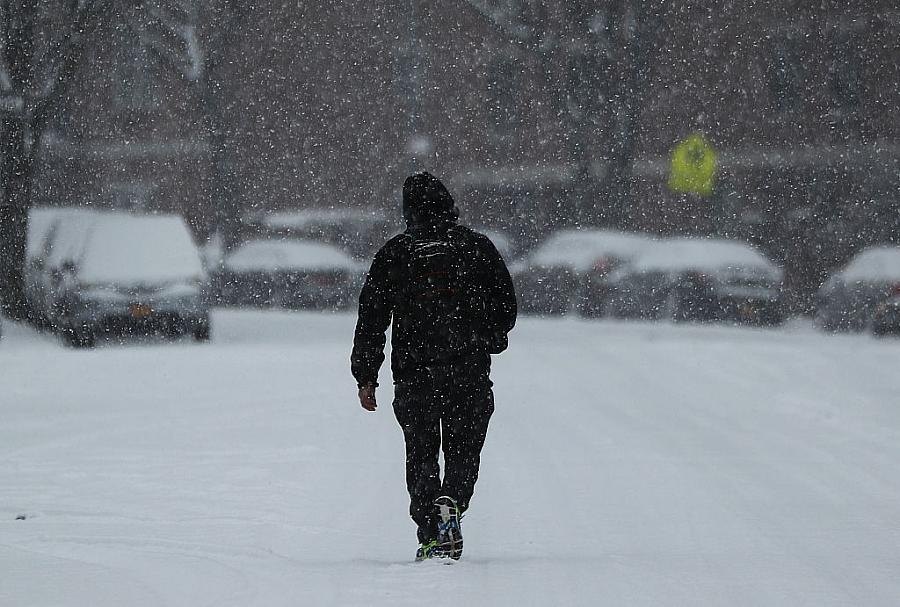What happens when racism and stress weather a body? This journalist has lived it.

(Photo by Spencer Platt/Getty Images)
Issac Bailey couldn’t figure out why his health had suddenly declined.
At 40 years old, the freelance journalist, author and James K. Batten Professor of Public Policy at Davidson College went from a 20-minute 5K and easily doing “gobs and gobs” of push-ups and pull-ups to developing an autoimmune disorder where his immune system attacked his body’s nerve endings. He almost died in the hospital.
Then while working on an assignment, he came across the research of Arline C. Geronimus, a professor in the department of health behavior and health education at the University of Michigan. Early in her career, Geronimus coined the term “weathering” to describe the health toll that dealing with daily hardships such as poverty and racism can cause on the body, resulting in premature aging and disease before people are chronologically old.
Suddenly Bailey’s transformation from a picture of health to nearly losing his life all started to make sense. In a presentation via Zoom to journalists taking part in the Center for Health Journalism’s 2021 National Fellowship this week, Bailey talked about his revelation, while Geronimus spoke about what she has learned in more than three decades of studying weathering.
“I felt a flash of recognition when I came across her research,” Bailey said.
“It made me feel as if I was not crazy after all. In my work and in my family life as well, it was always obvious to me that these kinds of effects were happening. You almost feel it in your bones essentially.”
Bailey grew up in extreme poverty in South Carolina in a very segregated, “sundown” town where African Americans knew it was not safe to go out at night. When he was 9 years old, his brother murdered someone and went to prison, a life-changing event that would take Bailey 25 years to understand the full impact it had on him.
Under the weathering model Geronimus outlined, the daily stresses Bailey and others experience that result from poverty and systemic racism, such as wondering where the next meal will come from, or having to work three jobs to make ends meet and take five busses to reach those jobs, keeps the body in a constant state of vigilance. Over time this can wear human bodies down at the cellular level, Geronimus said.
According to the theory, this constant navigation through a racist world over a lifetime is what leads to African Americans to suffer chronic diseases such as diabetes and heart disease at higher rates than white Americans and having a shorter life expectancy, gaps that have only grown over time. The disparities become more prevalent as people get older. Exposure to chronic stressors wears down major systems of the body: cardiovascular, immune, metabolic.
“Those systems over time become dysregulated or exhausted and the cell integrity that makes up those systems is violated, and that leads to an accelerated biological, cellular aging that increases general health vulnerability,” Geronimus said.
Weathering can take place at any age and before the onset of disease, Geronimus said. In fact, the period of life from youth to middle age is when people typically have the biggest burdens, supporting families and making ends meets economically. They are likely weathering and setting themselves up for future health issues.
So what can be done to stop or slow the weathering phenomena?
Bailey is skeptical of solutions that focus on educating people to understand racism and their biases. The backlash against teaching critical race theory, or the role race has played in the U.S., is evidence of the resistance to addressing the country’s race problem, he said. Instead, Bailey believes changing policies that support systemic racism is the key. It’s also an approach he shares with prominent author and scholar Ibram X. Kendi, author of “How to Be an Antiracist.”
“That will force the issue. I no longer believe that a whole lot of white people want to unlearn racism,” Bailey said. “If we wait for that to happen then it is probably never gong to happen.”
Ideally, we would teach children about structural racism as early as first grade, Geronimus believes. But instituting that type of curriculum is something that would need to be done over time. Meanwhile, there are ways to reduce the weathering that people experience. For instance, making the public transportation system more efficient so it doesn’t take five hours to get to work, or making affordable housing closer to job hubs.
Journalists can also play a role by writing more about how weathering leads to poor health outcomes for African Americans and other people of color, Bailey said. Too often journalists write about people overcoming extreme odds, but not the complexities and policies that created the hardships in the first place. This oversimplification misses the broader issues that need to be addressed.
“What we have done unfortunately sometimes as journalists is to reinforce this myth that it is about the individual overcoming of stuff,” Bailey said.
Geronimus has found that people’s stories are often told by others in a one-dimensional way and often ignore the hidden harms her research has shown those people suffer to overcome.
“They may have the most grit, they may have the most motivation, and whatever else, and they may do well,” she said. “But they weather too, and they weather young … We way over-valorize this idea of grit and resilience on an individual level without understanding the difficult price that is paid if you’re in a culturally and structurally oppressed group.”
Andrea K. McDaniels is a former Center for Health Journalism Fellow who is now freelancing after leaving her job at The Baltimore Sun after more than 20 years.

